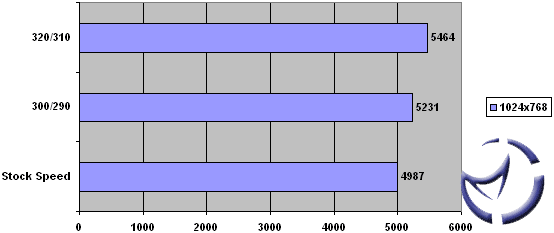|
TV-Out Quality
I grabbed an AVI file of Futurerama (captured from a cable feed), and outputted it to TV on both the AiW 8500DV, as well as on the AiW VE. I don't have a S-Video input on the television I used, so this was done via a composite cable. This should also test the quality of the AiW VE and the reputed improvements made with the Cobra Engine.
First, the 8500DV...

... and the VE...

The AiW VE has a noticably clearer picture, with a bit less grain in the image. I should note that the in order to acquire the image, I recorded the episode with the AiW VE. I then burned it to disc as a VCD, then recaptured it with the 8500 and the VE. What this test is supposed to illustrate then is the video capture quality of each card, and the resulting video output quality when using the same card to display the video. It would appear that the Rage Theater 200 and the Cobra Engine do improve upon the video quality.
Overclocking
The card isn't really designed for killer framerates, so there isn't really much point in overclocking in order to push more pixels. I had a random thought about overclocking to see if the MPEG encoding could be sped up any.
The stock speeds of the AiW VE are 260MHz for the GPU, and 250MHz for the ram. We moved in 5MHz increments, first with the core, then with the memory until we reached a failure point. Once that happened, we clocked it down, by 5MHz to the last stable OC, then moved up 1MHz at a time until we reach the maximum stable OC.
We managed to get as high as 320/310, but although the benchmarks completed, there was a lot of image tearing and corruption. Backing down to 305/300 cleared the problems, but after a few hours, we began to experience occasional lockups… during TV viewing! We lowered the speeds down a little more, and everything was fine at 300/290.
3D Mark 2001SE

As expected, performance scaled upwards as we increased the card's speed. I tried encoding the Futurama episode again, and despite the overclocking, there was no improvement in the encoding time, which was pretty much what I expected.
Final Words
No doubt, I sure there at least a few people who are wondering about the rating I'm about to give the All-In-Wonder VE. To understand my scoring, you'll have to look at the card for what it is. The intended market is for people who are saddled with an integrated video solution, who do not have an AGP slot. Truth be told, "enthusiasts" make up a small fraction of the PC population, and the majority of computers sold are based on these integrated motherboards. These consumers have absolutely no desire to fork over 500$ for a new video card, as well as a new motherboard with AGP, especially if these PCs are not used for anything other than basic web and word chores.
The picture quality and TV quality are excellent. The card offers the same functionality as its higher priced brothers, minus the 300fps in Quake 3. Herein lies the rub… power users will not be interested in the card for a number of reasons. It's PCI based, which is prehistoric in video card years, and lacks DX8 and DX9 hardware features. For casual gaming, it's fine, but if you're planning to run at 1600x1200 with everything on, it's not going to happen. The only other problem I have is the omission of the Remote Wonder. The remote isn't terribly expensive, but it's too bad ATi couldn't package one for an extra 30$.
By that same token, if you were looking to setup a secondary box, perhaps as a multimedia rig, or just as a secondary PC, the AiW VE would make a smart choice. For as , you get a lot of features for the money. You get serviceable 3D performance, a TV-tuner, a video editor, Pinnacle Studio (about 100$ on its own), and hardware accelerated video encoding. All of this on one PCI card, rather than one AGP (2D/3D), and a couple PCI slots (video editing and TV-tuner). The card is designed to bring the All-In-Wonder to the masses, and I think it succeeds with this product. One thing I haven't mentioned yet is the noise, which is none. Since passive cooling is all that's used, the card is noiseless, making it an even more attractive option proposition since most people would want a quiet multimedia box.
Essentially, it is a souped up TiVo on a card, with editing and output tools. It does so affordably, making it an ideal tool for casual multimedia directors. Anyone with an early generation (read: Pre-AGP) of Small Form Factor PC should certainly keep an eye on the AiW VE. A nice Shuttle barebone with an AiW VE would make a nice addition to the family room.

Pros: Low priced, feature rich, decent software bundle, Theater 200, TV-Tuner, silent.
Cons: No remote, not suited for those who consider themselves hardcore gamers.
Bottom Line: The AiW VE offers a budget upgrade for people with integrated video (or a horrible AGP, or PCI card) by allowing the card to fit into a PCI slot, which everyone has. The AiW VE does more than 2D and 3D though, as it offers a TV-tuner, video editing capabilities, and digital TV recording. If you got any comments, be sure to hit us up in our forums.
|



